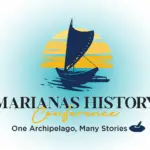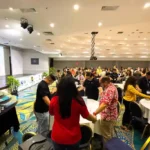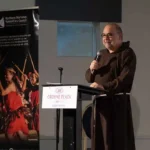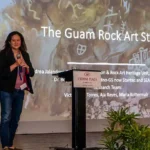6th Marianas History Conference
Table of Contents
Share This
More on the Marianas History Conference
- The Marianas History Conference Overview
- 2012 1st Conference Papers
- 2013 2nd Conference Papers
- 2016 3rd Marianas History e-Publication
- 2017 3rd Conference Papers
- 2019 4th Conference Papers
- 2021 5th Conference Papers
- 2023 6th Conference Papers
Since 2011, the Marianas History Conference (MHC) has been held every two years and is now the most prominent gathering of historians, scholars, students and researchers interested in the history, society and culture of the Mariana Islands. With the overarching theme of “One Archipelago, Many Stories,” the MHC provides a space for people of varying educational backgrounds, research interests and disciplines, hailing from different cultural, academic and political institutions to come together and share knowledge, active scholarship and research, past experiences and, of course, food and friendship.
The 6th Marianas History Conference (MHC6) convened on 1-3 September 2023, at the Crowne Plaza Resort in Garapan, Saipan, CNMI. The theme for this 6th MHC, “Healing the Wounds of History,” focused on healing practices in the Mariana Islands, health care issues, and sources of historical division in need of remedy. The 5th MHC, held during the throes of the COVID-19 pandemic, reminded the conference organizers of the value of healing and learning to move forward by looking to lessons from the past. The Mariana Islands have endured many historical wounds caused by events, attitudes or policies that have been disruptive, painful, traumatic, divisive or violent, with impacts that cross generations. The wounds from colonialism and displacement, diseases, war, and the military buildup, have left physical and emotional scars on the people and the lands of the Marianas. But while scars are reminders of pain and suffering, they also represent stories of healing, resilience and strength. Read more in Issuu here.
Conference Overview
Welcoming Remarks
By Conference Steering Committee Co-Chairs
Leo Pangelinan and Dr. Lawrence Camacho
Northern Marianas Humanities Council and University of Guam
Donald Mendiola, Keynote address
By Siñot Donald Mendiola
Yo’åmti/Classroom Teacher PSS—CCLHS, Åmut Natibu
Pale’ Eric Forbes, Keynote address
By Pale’ Eric Forbes, OFM Cap
Priest/Historian, Guam
Special Presentation
Reimagining the Marianas: An Evening with Humanities Guåhan and Northern Marianas Humanities Council
By Humanities Guåhan and Northern Marianas Humanities Council
Paper titles and abstracts
Overcoming Colonial Legacies
Overcoming Colonial Legacies: The Digital Reconstruction of the Palacio de Gobierno of the Mariana Islands as an Opportunity for Nation Building
By Dr. Carlos Madrid
Associate Professor of Spanish Pacific History
University of Guam and Hagåtña Restoration & Redevelopment Authority
This presentation explores the digital reconstruction of the Palacio de Gobierno, the former government residence and offices of the colonial government of the Mariana Islands and Guam. Despite the lack of visual documentation, we delve into the process of determining the building’s interior, including room usage, the private and public wings, and the furniture it once housed.
Utilizing enhanced reality, the BISITA App recreates historical scenarios, including the fully reconstructed city of Hagåtña as it appeared in the 1890s, paving the way for the detailed recreation of the Government Palace. This digital representation of history offers a new approach to understanding the past, complementing traditional methods such as stage presentations and literature.
By embracing digital means, we overcome the challenges posed by colonial legacies and contribute to nation building. The reconstruction of the Palacio de Gobierno serves as a catalyst for a deeper appreciation of our cultural heritage. It fosters a deeper comprehension of history, facilitating the development of a cohesive and informed society. Join us in exploring this remarkable journey and the transformative potential of digital technology in re-presenting history. View in Issuu here.
Effectiveness of 2020 Airborne Lidar for Identifying Archaeological Sites and Features on Guåhan (Guam)
By Andrea Jalandoni, Boyd Dixon, Maria Kottermair, and Victor Hara Torres
Griffith University, AU; Cardno GS and SEARCH, GU; University of Queensland, AU; and Independent Archaeologist, GU
Guåhan (Guam), part of the Mariana Islands in the western Pacific, has an archaeological record spanning almost four millennia. In this seminal academic paper on the use of lidar for archaeological investigation on Guåhan, we determined which known sites can be visually detected to explore the effectiveness of lidar in this context. Several archaeological site types and features from the Latte, Spanish, and Modern Periods were examined using high-resolution 2020 airborne lidar. We generated the most commonly used digital elevation models (DEMs), which are digital terrain models (DTMs) and digital surface models (DSMs), and visualised them as a hillshade. Lidar proved effective for identifying all the Modern Period sites and most of the Latte and Spanish Period sites, although some features remained obscure. Major challenges and limitations of using lidar on Guåhan were vegetation, site size, and visual ambiguities. While this study used conventional lidar derivatives, it exposed the potential to find more archaeological sites by applying more complex lidar processing techniques in the future. The benefits of lidar are of great interest to the local community, especially the Indigenous CHamoru/ Chamorro, interested in non-destructive ways to assist their cultural heritage management. View in Issuu here.
Exploring the Sexual Wounds of Spanish Colonization in Tåno Låguas yan Gåni (the Mariana Islands) during the Late 17th Century
By Enrique Moral de Eusebio
Universitat Autònoma de Barcelona/Universitat Pompeu Fabra
At first, CHamoru/Chamorro communities welcomed with hospitality the Jesuits who settled on the shores of Tåno’ Låguas yan Gåni (the Mariana Islands) in June 1668. However, the evangelizing ambitions of the newcomers, which sought to disrupt most of CHamoru lifeways (including sexuality), soon led to armed conflicts between both populations. The aim of this paper is to explore the role that sexual encounters, practices, and beliefs played in these conflicts, which, following archaeologist Barbara L. Voss, will be partially understood as ethnosexual conflicts. I examine how certain institutions linked to sexuality were at the center of these confrontations, such as the guma’ ulitao or the practice of repudiation between CHamoru couples, as well as the Christian sacrament of indissoluble marriage and the Jesuit schools as the new spaces of (sexual) socialization for the CHamoru youth. Finally, my hypothesis is that these conflicts opened a first sexual wound in the CHamoru communities, which were stripped of their traditional sexual practices and beliefs, as well as they led to deeper wounds (such as sexual violence) during the subsequent period known as La Reducción. View in Issuu here.
Emotional Wounds Carved in Space
Emotional Wounds Carved in Space: The Impact of Spanish Colonization on CHamoru/Chamorro Spatiality
By Yvonne Rocío Ramírez Corredor
PhD Student
Universitat Pompeu Fabra
This paper explores the ways in which space was constructed, organized, and lived during the Spanish colonial period in the Mariana Islands. I will specifically focus on the ontological and emotional impact that the new colonial order had on the inhabitants of the archipelago during the seventeenth and eighteenth centuries. In this context, the purpose of my historical research is to highlight the importance of space in the colonization process at the material and relational level. I start from the premise that the colonial organization of space that we know as “La Reducción” implied a series of actions such as the forced relocation of the Indigenous population, both within the islands and between the islands themselves. This process of forced relocation caused a great ontological disorientation to the CHamoru/Chamorro communities, regarding their lifeways and social organization in their own territory. The wounds of uprooting, carved in the relationship between people and the natural and cultural landscape of the islands, as well as in their ways-of-being in the mountains and in the sea, also implied new forms of resilience and cultural resistance expressed in space, many of them enduring to this day in the spirit and identity of the CHamoru people. View in Issuu here.
Contrasting Healways
Contrasting Healways: Colonization by Pathologization and Resistance through CHamoru Healing during the Spanish Colonization of Tåno’ Låguas Yan Gåni
By Matilde Carbajo
PhD Candidate and La Caixa INPHINIT Fellow
Universitat Pompeu Fabra
During the Early Modern period, the Pacific saw significant encounters between different healing paradigms. In Tåno’ Låguas yan Gåni, about it meant the juxtaposition of Latte CHamoru/Chamorro healways, rooted in Indigenous practices and beliefs, and Colonial perspectives on illness, healing and therapeutic relationships, which were mostly influenced by Christian ideas of the world. The establishment of a Catholic mission in the archipelago, after 1668, interlaced Indigenous and Colonial healways with the power dynamics of colonialism. Healing processes were either instrumentalized as vehicles of colonization or acquired new meanings as ways of resistance. In this contribution, I explore different strategies of colonization by medical means, such as the pathologization of Indigenous resistance, the attempt to replace local kinship collective dynamics of healing with the assistance of the missionaries, or the enforced Christianization of local spiritual healing practices. During the Spanish colonization of Tåno’ Låguas yan Gåni, CHamoru healways were not only a means of providing physical health and spiritual relief but also served as acts of preservation of CHamoru identities. View in Issuu here.
I Manmalingu na Songsong Lagu
I Manmalingu na Songsong Lagu: Archaeology at Mågua’ and Sabånan Fadang
By Cacilie Craft
Pacific Program Manager
Kleinfelder Inc.
Kleinfelder, Inc. (KLF) has been conducting archaeological investigations associated with the new construction of Marine Corps Base Camp Blaz (MCBCB) for the last ca. 4 years. This work has included archaeological survey, subsurface testing, data recovery, burial recording, and monitoring of construction. During this time, KLF has encountered substantial evidence of Pre-Contact to late Historic Period use of the plateau by indigenous communities, particularly within the areas of Mågua’ and Sabånan Fadang. Fieldwork is now complete and KLF is commencing the robust laboratory and reporting efforts. This presentation provides a brief contextual overview of KLF’s archaeological investigations at Mågua’ and Sabånan Fadang. This includes a presentation of map figures to provide locational context as well as an overview of findings and research objectives. The history of land use within what is now Marine Corps Base Camp Blaz will also be reviewed, beginning with two concentrations of Pre-Contact activity on the plateau through historical ranching to World War II conflict and subsequent military ownership. View in Issuu here.
Listening for Hinemlo, Sounds of Rice, and Healing in the Marianas
By Andrew Gumataotao and Donald Mendiola
Researcher, Georg-August Universität Göttingen; and Yo’åmti/Classroom Teacher PSS–CCLHS, Åmut Natibu
Medicinal practices of the Marianas have long persisted throughout generations however, due to overwhelming environmental transformations such as deforestation due to military activities and tensions between federal conservation efforts that are at odds with indigenous perspectives, both knowledge practices and the land itself are increasingly at risk more than ever before. Up until recently, little attention has been placed in terms of how sonic traces in chant and ceremony converge at the nexus between efforts to perpetuate traditional healing practices and protecting land as ancestor. Today, community members are increasingly placing more value on resurgences in ceremonial protocol grounded in Chamorro/CHamoru understandings and relationships to place in response to concurrent projects that are forcing the disappearance of limestone forests which are primary areas with which to make such medicines. Following the conference theme “Healing from the Wounds of History”, this panel seeks to situate how modalities such as sound, chant and indigenous spiritualities are important for healing. Andrew Gumataotao will present his fieldwork experiences that began amid the dire dilemma during the Covid Pandemic while working towards how music and sound-based practices are crucial for healing in the Marianas. To listen to how healing contours can potentially sound like, this panel will listen attentively to the sonic traces of Lålai Få’i linking it to storied pasts and current initiatives to reconnect intimately to and further create stewardship land. In conversation with Saina Frances Manibusan Sablan, and Hohomlu’ Tun Donald Mendiola, we will endeavor to connect more broadly to the wider realm of medicine and healing, aiming to give critical commentary on healing practices in the Marianas both in the sonic and medicining materialities. View in Issuu here.
Humanizing War Histories
Humanizing War Histories: Japanese Names in the Asan Bay Overlook Memorial Wall
By Maria Cynthia Barriga
Assistant Professor
Waseda University
The presentation centers on the Japanese locals included in Guam’s Asan Bay Overlook Memorial Wall with the aim of humanizing racialized war histories. To situate the study, the presentation first shows the challenge in Guam’s war historiography. Since the 1980s, CHamoru/Chamorro studies has critiqued the US Liberation grand narrative, particularly its portrayal of CHamorus as passive loyal subjects. Despite this historiographical development, however, “The Japanese Enemy” remains to be a racial trope from which Guam’s Japanese locals have often needed to dissociate themselves. To address this problem, the presentation zooms in on the Japanese names in Guam’s war memorial for Americans and CHamorus who died and suffered during the war against Japan. By searching for these Japanese names in prewar sources, oral histories, and other contemporary war memorials, the presentation reveals their humanity as well as their inclusion in the island community on the eve of the war, the immediate postwar, and even today. In juxtaposing the “Japanese Enemy” trope in war narratives and the plurality of Guam’s Japanese locals, I wish to invite the audience to rethink how war experiences are narrated and how their narratives can make enemies of fellow locals in the island community. View in Issuu here.
The Tinian North Field National Historic Landmark
By Don A. Farrell
Scholar
Northern Marianas Humanities Council
In 1984, the people of the Commonwealth of the Northern Mariana Islands petitioned the National Park Service (NPS) for a National Park to be established at the Tinian North Field Complex. The submission was approved by the National Park Service, but was declined by the United States Navy, stating that they might need to use the area for training purposes in the future. The NPS subsequently designated the area a National Historic Landmark.
During the 60th Anniversary of the invasion and capture of Tinian, 2004, the Mayor of Tinian excavated the atomic bomb loading pits at North Field. Comparing photographs from Record Group 77, US National Archives, to the interior structure of the pits, it became obvious that both bombs were loaded from the same pit. This contradicted the interpretive signs at the pits, as created by the National Park Service, and began the quest to revisit the history of the Tinian North Field National Historic Landmark and make corrections to the boundaries and the list of historic sites, as necessary.
Thanks to a grant from the National Park Service, a new nomination packet for designating the Tinian North Field as a National Historic Landmark has been completed by the Northern Marianas Humanities Council. The purpose of this paper is to document the status of a project developed by the Humanities Council to expand the boundaries of Tinian North Field National Historic Landmark and develop and install interpretive waysides to mark the historical significance of at least 20 sites within these boundaries. View in Issuu here.
Humanity in War
Humanity in War: Guy Gabaldon at the Battle of Saipan
By Ron McNinch
Chair, Public Administration and Legal Studies Division
University of Guam
This paper and presentation will cover the Guy Gabaldon story. As a part of the USMC force securing Saipan, Gabaldon rescued hundreds of civilians and combatants from the battle lines to safety. Details of Gabaldon’s early life and the formative aspects of his youth will be discussed to explain how and why Gabaldon was able to accomplish his good deeds. View in Issuu here.
Indigenous Rights
Indigenous Rights: A Pathway to End American Second-Class Citizenship
By William J. Fife III and Beylul Solomon
Associate Professor of Social Sciences and Fine Arts; and Associate Professor of Education for Rehabilitation and Human Services Concentration
Northern Marianas College
Nearly 4 million American residents in US territories are second-class citizens, lacking individual and collective voting rights and burdened with other gross socioeconomic and healthcare disparities. These disparities affect many honorable veterans that suffer from physical and mental injuries due to fighting for rights they themselves do not possess. The Insular Cases, self-determination, and critical race theory are current hot topics in Washington DC. Out of the five US territories, only Guam, Puerto Rico, and the US Virgin Islands fully supported a resolution denouncing the systemically racist Insular Cases at a Congressional hearing in 2021. Even Trump-appointed Supreme Court of the United States (“SCOTUS”) Justice Gorsuch called for the end of the Insular Cases in 2022. The Commonwealth of the Northern Mariana Islands (“CNMI”) and American Samoa had reservations about fully supporting the resolution due to concerns regarding cultural survival. Legislative solutions to address the prejudiced language in the Insular Cases and the overall nature of second-class citizenship in US territories, which would require statehood to remain American, have yet to materialize. Implementing the United Nations Declaration of the Rights of Indigenous Peoples (“UNDRIP”) through local and federal legislation could be a consensus-based solution to not only replace the Insular Cases but also overturn what this Article will refer to as the Discovery Cases – rulings linked with Johnson v. M’Intosh, which include the Insular Cases. Indigenous rights protections could also provide interest toward statehood for the CNMI, as well as potential reunification with Guåhan. UNDRIP-based legislation could end Pacific territories’ concerns regarding closer integration with the US by ensuring Indigenous rights and simultaneously laying a foundation to end second-class citizenship in America. View in Issuu here.
Rethinking "Village" and "Community" in Ancient CHamoru Society
By Dr. Boyd Dixon and Aja Reyes
Archaeologist, Stantec, and SEARCH; and Marine Biologist, Field Scientist, and GISAnalyst
The profession of archaeology, as practiced in Guam and the Northern Mariana Islands, is challenged to define the nature and limits of the traditional Latte Period CHamoru/Chamorro “village” as used in public discourse today. Today, it appears many villages are recognized by extended families and their long-term neighbors who have occupied one locally defined landscape over generations. The contemporary term “community” is therefore proposed here instead of village when referring to a broader range of Latte Period archaeological sites and associated activities such as ceramic manufacture presumably integrated especially during times of shared need and celebration. View in Issuu here.
Healing History through Science
Accordion Content
Healing History through Science
Healing History through Science: How Ancient and Modern DNA Analysis Confirms Chamorro Authenticity in the Mariana Islands
By Joanne E. Eakin and Rosalind L. Hunter-Anderson
Independent Researchers
The origins of the indigenous people of the Marianas have been obscured by the inaccurate writing of history that lacks a scientific perspective. This failing has led to the hurtful denial of Chamorro/CHamoru ethnic authenticity and legitimacy. Our paper shows how this intergenerational wound can be healed, in part, through the study of ancient and modern DNA from the Marianas. Here we present strong evidence from Guam and Saipan that points to Chamorro origins in the east-central islands of Indonesia, and to a remarkable continuity in both biological heritage and social practices between the first permanent settlers of the Mariana Islands 2800 years ago and present-day Chamorros. We also present new information about ancient migration streams into this region, family relationships, and lifestyle, obtained by way of advanced DNA analysis, which demonstrates the healing power of science to affirm Chamorro indigeneity and ethnic authenticity in a fraught political context. View in Issuu here.
Remembering the Language of Mollusk Collecting
Healing the Wounds of History: Remembering the Language of Mollusk Collecting
By Judith R. Amesbury and Angelina Pangelinan
Senior faunal analyst and Archaeologist
Kleinfelder
This presentation reports on a project funded by Humanities Guåhan (Guam Humanities Council) to collect Chamorro/CHamoru names of mollusks and other invertebrates. The names were collected from elderly Chamorro speakers. The informants provided other information about mollusk collecting as well. The project helps to heal two wounds of history: 1) During the Spanish colonization, Chamorro society was changed from a seafaring society to an agricultural society; 2) During the American colonization, the used of Chamorro language was limited. By writing information about the collection of mollusks and other invertebrates, this project made a record of a part of the history and culture of Chamorro people. View in Issuu here.
"Chinchuli:" An Evil That Has No End?
“Chinchuli:” An Evil That Has No End? Chamorro Reciprocal Exchange System during the time of Governor Felipe de la Corte (1855-1866)
By Michael Richard Clement, Jr.
University of Guam
In 1853, Spain’s tenuous hold on the Western Pacific was vulnerable to aggression from much stronger rival imperial powers. In response, the Governor General of the Philippines appointed the unusually well qualified Lieutenant‐Colonel Felipe de la Corte y Ruano Calderon to the governorship of the tiny province of the Mariana Islands. The reform minded governor spent 11 years on Guam persistently studying the island and its people as he developed plans for reform and modernization. Among his numerous observations was that at least in his mind, the indigenous Chamorro/CHamoru reciprocal exchange system known as “chinchuli” was extremely inefficient and was a primary obstacle to progress. This presentation rereads Governor de la Corte’s bitter, but also very detailed and informative complaints about the Chamorro culture of the time. A case is made that de la Corte’s reports provide incredible insights into the way the indigenous population of the island was able to maintain an autonomous identity despite nearly 200 years of colonial domination up that point in history. But also, that de la Corte’s reports are still relevant today as 21st century Chamorros, and other Pacific peoples, continue to negotiate tensions between communal obligations and the cultural structures of the modern world. View in Issuu here.
History and Identity in the Mariana Islands
History and Identity in the Mariana Islands: Narratives and Tropes of the Seventeenth Century Encounter
By David Atienza
Associate Professor in Anthropology
University of Guam
We narrate identities, so they require verb tense and historical contexts where the plot occurs and develops. Like liquid in a container, every story adapts to the main ideological structures of its contemporary historical context. Therefore, speaking about identities is speaking about ideology, history, and the novel. This presentation analyzes some “historical tropes” developed in the last decades that strongly influenced the construction of identities in the Mariana Islands. These tropes had affected the interpretation of the encounter between CHamoru/Chamorro and non-CHamoru people in the Seventeenth Century, and therefore the self-construction of identities. View in Issuu here.
The Origin of CHamoru/Spanish/English Trilingual Education on Guam
By Malia A. Ramirez
Historian
Self / Researcher / CHamoru Studies
View in Issuu here.





